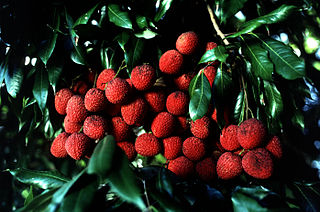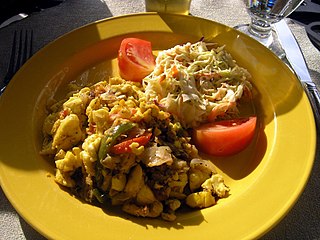
Meliaceae, the mahogany family, is a flowering plant family of mostly trees and shrubs in the order Sapindales.

Melicoccus bijugatus is a fruit-bearing tree in the soapberry family Sapindaceae, native or naturalized across the New World tropics including South and Central America, and parts of the Caribbean. Its stone-bearing fruits, commonly called quenepa, ‘’’kenèp’’’ or guinep, are edible. Other names for the fruits include limoncillo, Bajan ackee, chenet, Spanish lime and mamoncillo.

The ackee, also known as acki, akee, or ackee apple, is a fruit of the Sapindaceae (soapberry) family, as are the lychee and the longan. It is native to tropical West Africa. The scientific name honours Captain William Bligh who took the fruit from Jamaica to the Royal Botanic Gardens in Kew, England, in 1793. The English common name is derived from the West African Akan-language name akye fufo.

The Sapindaceae are a family of flowering plants in the order Sapindales known as the soapberry family. It contains 138 genera and 1,858 accepted species. Examples include horse chestnut, maples, ackee and lychee.

An aril, also called an arillus, is a specialized outgrowth from a seed that partly or completely covers the seed. An arillode or false aril is sometimes distinguished: whereas an aril grows from the attachment point of the seed to the ovary, an arillode forms from a different point on the seed coat. The term "aril" is sometimes applied to any fleshy appendage of the seed in flowering plants, such as the mace of the nutmeg seed. Arils and arillodes are often edible enticements that encourage animals to transport the seed, thereby assisting in seed dispersal. Pseudarils are aril-like structures commonly found on the pyrenes of Burseraceae species that develop from the mesocarp of the ovary. The fleshy, edible pericarp splits neatly in two halves, then falling away or being eaten to reveal a brightly coloured pseudaril around the black seed.

Artocarpus integer, commonly known as chempedak or cempedak, is a species of tree in the family Moraceae, in the same genus as breadfruit and jackfruit. It is native to Southeast Asia. Cempedak is an important crop in Malaysia and is also popularly cultivated in southern Thailand and parts of Indonesia, and has the potential to be utilized in other areas. It is currently limited in range to Southeast Asia, with some trees in Australia and Hawaii.

The scarlet gourds are a genus with 25 species. It is distributed in sub-Saharan Africa and with one species, C. grandis also in South Asia and Southeast Asia, and it is also introduced into the New World. Incidentally, C. grandis is also a cultivated crop and it is used for culinary and medical purposes.

Artocarpus odoratissimus is a species of flowering plant in the Moraceae family. It is a commonly called marang, madang, timadang, terap, tarap, kiran, green pedalai, or johey oak. It is native to Borneo, Palawan, and Mindanao Island, and is closely related to the jackfruit, cempedak, and breadfruit trees which all belong to the same genus, Artocarpus.

The ackey was a currency issued for the Gold Coast by the British between 1796 and 1818. It was subdivided into 8 takoe and was equal to the British halfcrown, i.e., 1 takoe = 33⁄4 pence and 1 pound = 8 ackey.

The red-flanked duiker is a species of small antelope found in western and central Africa in countries as far apart as Senegal and Sudan. Red-flanked duikers grow to almost 15 in (38 cm) in height and weigh up to 31 lb (14 kg). They have russet coats, with greyish-black legs and backs, and white underbellies. They feed on leaves, fallen fruits, seeds and flowers, and sometimes twigs and shoots. The adults are territorial, living in savannah and lightly wooded habitats, and the females usually produce a single offspring each year. They have lifespans of ten to fifteen years in captivity.
Jamaican vomiting sickness, also known as toxic hypoglycemic syndrome (THS), acute ackee fruit intoxication, or ackee poisoning, is an acute illness caused by the toxins hypoglycin A and hypoglycin B, which are present in fruit of the ackee tree. Unripe arils contain concentrations of hypoglycin A that are 20-fold higher than those of ripe arils, and can cause vomiting and even death. Some countries in the Caribbean and Western Africa experience frequent cases.

Diploglottis is a genus of 11 species in the lychee and maple family Sapindaceae. Most species only occur in the Wet Tropics bioregion of Queensland, but all species except one are endemic to eastern Australia, with the exception being D. diphyllostegia, which also occurs in New Guinea. They are commonly called tamarinds, for example northern tamarind, Babinda tamarind and Bernie's tamarind, however they are not closely related to the true tamarind from the family Fabaceae.

Hypoglycin A is a naturally occurring amino acid derivative found in the unripened fruit of the Ackee tree and in the seeds of the box elder tree. It is toxic if ingested, and is the causative agent of Jamaican vomiting sickness. A 2017 Lancet report established a link between the consumption of unripened lychees resulting in hypoglycaemia and death from acute toxic encephalopathy.

Hypoglycin B is a naturally occurring organic compound in the species Blighia sapida. It is particularly concentrated in the fruit of the plant especially in the seeds. Hypoglycin B is toxic if ingested and is one of the causative agents of Jamaican vomiting sickness. It is a dipeptide of glutamic acid and hypoglycin A.

Ackee and saltfish is the Jamaican national dish prepared with sautéed ackee and salted codfish.

Boschia grandiflora, the ghost durian or durian munjit, is a tree endemic to the island of Borneo.

Inga edulis, known as ice-cream bean, ice-cream-bean, joaquiniquil, cuaniquilguama or guaba, is a fruit native to South America. It is in the mimosoid tribe of the legume family Fabaceae. It is widely grown, especially by Indigenous Amazonians, for shade, food, timber, medicine, and production of the alcoholic beverage cachiri. It is popular in Peru, Ecuador, Pernambuco-Brazil, Venezuela, Guyana and Colombia. The taxonomic name Inga is derived from its name with the Tupí people of South America (ingá) while the species name edulis is Latin for "edible". The common name "ice-cream bean" alludes to the sweet flavor and smooth texture of the pulp.
Nina Lilian Etkin was an American anthropologist and biologist. Etkin was noted for her work in medical anthropology, ethnobiology, and ethnopharmacology. She studied the relation between food and health for over thirty years. Her work involved complementary and alternative medicines for prevention and treatment in Hawai‘i; the use of ethnomedicines in Indonesia; and health issues in Nigeria. She won numerous grants and awards from national and international agencies and published several books as well as over 80 professional articles in peer reviewed journals.

Methylene cyclopropyl acetic acid (MCPA) is found in lychee seeds and also a toxic metabolite in mammalian digestion after eating hypoglycin, present in the unripe ackee fruit, grown in Jamaica and in Africa. By blocking coenzyme A and carnitine, MPCA causes a decrease in β-oxidation of fatty acids, and hence gluconeogenesis.

Diploglottis diphyllostegia, commonly known as the northern tamarind, native tamarind or wild tamarind, is a tree in the lychee family Sapindaceae which is endemic to Queensland, Australia. It is an attractive tree with potential in cultivation, with a dense crown of dark green leaves and masses of fruit in spring and summer.

















